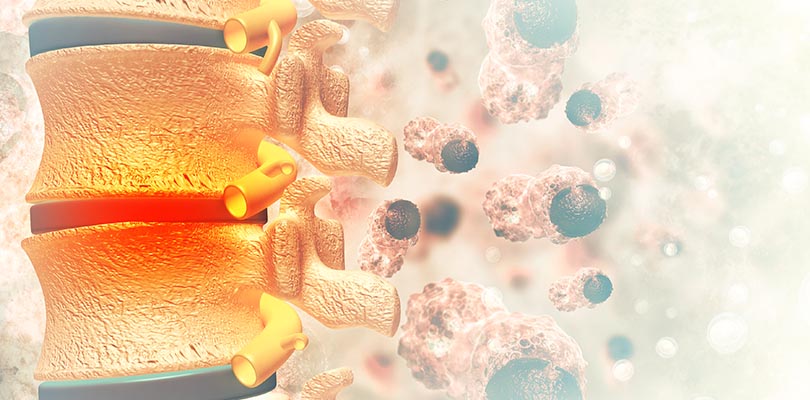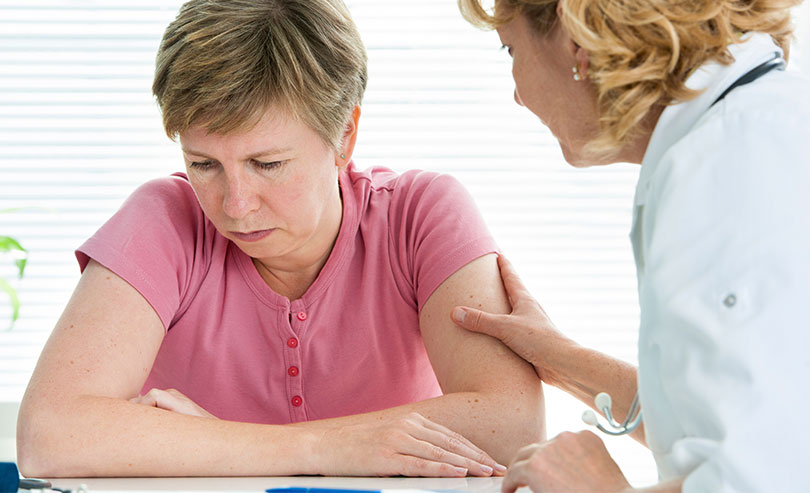Ovarian Cancer Signs and Symptoms
There are some medical conditions that are unique to women, such as ovarian cancer. Ovarian cancer is the most serious type of women’s cancer, which may be because it is usually found in later stages. Due to it being found in later stages, it is smart to know about ovarian cancer signs and symptoms so that you can be aware of when they first occur.
What Is Ovarian Cancer?
Ovarian cancer is the fifth most common cancer for women. It originates in the ovaries, where eggs, estrogen and progesterone are produced. When normal cells develop mutations in their DNA, the abnormalities may become cancer. Mutated cells do not adhere to the usual cell life cycle; they keep living when healthy cells would die off. Abnormal cells may keep growing and multiplying quickly to create a tumor, which may or may not be cancerous. Cancer cells may even invade other tissues in the body and spread, or metastasize, to a secondary location.
Types of Ovarian Cancer
There are a few types of ovarian cancer and are differentiated by where the cancer cells grow.
- Epithelial tumors. These begin in the thin layer of epithelial cells which cover the outside of the ovaries. A vast majority of ovarian cancers are epithelial tumors.
- Stromal tumors. These begin in the structural tissue that hold the ovary together. This type of tumor is more likely diagnosed in an earlier stage than other types of ovarian cancers. Less than 7% of ovarian tumors are stromal.
- Germ cell tumors. They begin inside the ovary where the eggs are produced. Cancers that start here are rare and occur more often in younger women.
Symptoms of Ovarian Cancer
In its early stages, ovarian cancer rarely causes symptoms; it may go undiagnosed until it gets to later stage cancer. A reason this happens is because the symptoms are not obvious, or they are mistaken for common ailments, usually stomach or digestive issues.
When ovarian cancer reaches more advanced stages, some symptoms may be:
- Abdominal bloating or swelling
- Changes in appetite, such as loss of appetite or quickly feeling full
- Discomfort in the pelvis area or lower back
- Changes in bowel movements
- Changes in menstruation
- Tiredness or low energy
- Weight loss
- Frequent need to urinate
There are additional symptoms once a pelvic cyst, mass, or tumor develops. Symptoms at this stage may vary:
- Pelvic pain
- Abnormal bleeding
- Nausea and vomiting
- Pain before or after your period
- Ache in the lower back and thighs
- Difficulty emptying the bladder
- Discomfort during sex
Leukemia symptoms may vary from person to person and the type of leukemia an individual has. Read on to know more about the symptoms of leukemia here.
How Ovarian Cancer Is Diagnosed
Unfortunately, there is not a reliable screening test for ovarian cancer. Due to the lack of symptoms, only about 20% of cases are diagnosed in early stages of ovarian cancer. If you have symptoms of ovarian cancer, your doctor will be able to perform some tests.
Ovarian cancer testing generally involves a combination of tests including a complete pelvic exam, ultrasound and a CA-125 blood test. The use of an ultrasound will show the physician the size, shape, location and other details of the mass so they can determine next steps. If required, the doctor may also call for a CT scan or PET scan to assist in the diagnosis. To confirm a diagnosis, the only way to see whether or not ovarian cancer is present is to have a biopsy done.
Causes of Ovarian Cancer
There are no clear causes for ovarian cancer. There are cases where an ovarian cancer diagnosis is just bad luck, but there are some factors that may indicate increased risk:
- Older age. Ovarian cancer is more common in women over 50 but can occur at any age.
- Inherited gene mutations. A small percentage of ovarian cancers are caused by mutations to the breast cancer gene 1 (BRCA1) and breast cancer gene 2 (BRCA2).
- Weight. There is increased risk in those who were obese in early adulthood.
- Endometriosis. This condition may increase the risk of certain types of ovarian cancer.
- Hormone replacement therapy (HRT). Ovarian cancer risk increases especially with long-term use or large doses of HRT.
- Family history. If there is a history of ovarian cancer in the family, your risk goes up.
- Age when menstruation started and ended. Beginning menstruation early or starting menopause late (or both) may increase risk.
- Genetic conditions. Some conditions, such as lynch syndrome, Peutz-Jeghers syndrome, or nevoid basal cell carcinoma syndrome, carry increased risks.
Treatments for Ovarian Cancer
As ovarian cancer is often detected in the later stages, it is usually not discovered until it is spread within the pelvis and abdomen and is more difficult to treat. Generally, treatment options at this point are:
- Chemotherapy to shrink the tumor
- Targeted therapy
- Hormone therapy
- Surgery to remove the tumor
- Surgery to remove the ovaries or fallopian tubes (which may also require removal of the uterus, cervix, omentum and lymph nodes)
Prevention Plans
If you fall into one of the higher risk categories for getting ovarian cancer, there are some preventative actions that may help:
- Discuss risk factors with your doctor. If they think you may be higher risk, they may refer you to a specialist to do some genetic testing.
- Make healthy changes to your lifestyle
- Take birth control pills
- Having children as more full-term pregnancies to reduce risk
- Breastfeed as long as possible
- Surgical procedures such as a hysterectomy (removal of the uterus) or tubal ligation (having the fallopian tubes “tied”). Other surgeries, such as a bilateral salpingo-oophorectomy (removal of both ovaries and fallopian tubes) may be suitable for women who are high risk.
Your daily to-do list may be very long, but make sure your health stays a priority. Don’t put off a doctor’s visit if you have symptoms that bother you. The overall message, ladies, is to take care of yourselves.







